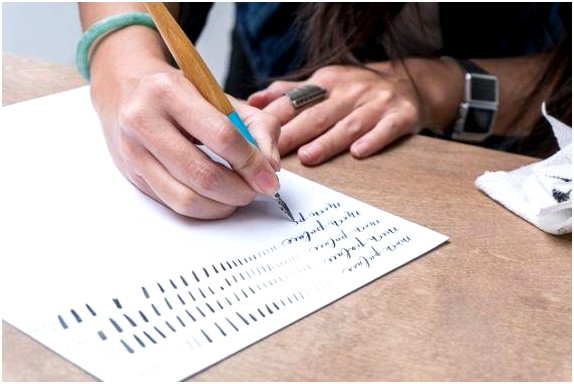Navigation article:
- Speedball Calligraphy Collector’s Set
- A good starter kit
- A cheaper kit
- The best nib
- The best holder
- Our favorite ink
- Best grid paper
- Better for tracing
- A brush-pen alternative
- A good starter kit
- A cheaper kit
- The best nib
- The best holder
- Our favorite ink
- Best grid paper
- Better for tracing
- A brush-pen alternative
- The research
- Why you should trust us
- What you need to get started with calligraphy
- How we picked and tested
- Best starter calligraphy kit: Speedball Calligraphy Collector’s Set
- A good starter kit
- A cheaper kit
- Best calligraphy nib: Tachikawa G
- The best nib
- A slightly stiffer nib
- Best holder: Tachikawa T-40 Comic Pen Nib Holder
- The best holder
- A lighter holder
- Best ink: Moon Palace Sumi Ink
- Our favorite ink
- A less-colorfast sumi ink
- Best practice paper: Rhodia dotPad
- Best grid paper
- Better for tracing
- A good brush pen: Tombow Dual Brush Pens
- A brush-pen alternative
- Calligraphy resources
- The competition
- The best deals, delivered daily
Updated June 15, 2017:
After testing 10 brush pens, we now recommend Tombow’s Dual Brush Pens if you want a simple, quick way to practice calligraphy or address some envelopes. We’ve also added a runner-up calligraphy kit,…
After testing 10 brush pens, we now recommend Tombow’s Dual Brush Pens if you want a simple, quick way to practice calligraphy or address some envelopes. We’ve also added a runner-up calligraphy kit, the Speedball Complete Calligraphy Kit, in case our main pick sells out (or if you know you want to upgrade to better nibs and holders).
After 25 hours of research, including interviews with four expert calligraphers and tests of more than 25 individual tools and kits with a professional calligrapher, we recommend the Speedball Calligraphy Collector’s Set for beginners. Individually, the tools in this kit aren’t the absolute best, but they are all solid, and with its variety of nibs, holders, and inks, this kit is a great way to get started with a range of calligraphy styles. It’s one of the most affordable kits we tried, and it comes with the nicest box for easy storage.
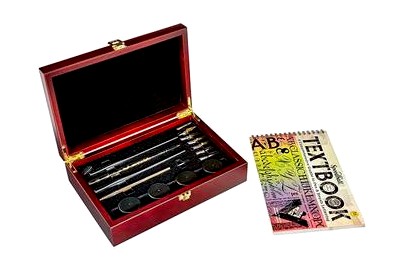
Speedball Calligraphy Collector’s Set
A good starter kit
This is the best affordable kit we tried. We like that its multiple nibs, holders, and ink fit in a sturdy wood box and that it comes with a fun font booklet.
Buying Options
*At the time of publishing, the price was $36.
If our main pick sells out, or if you want a kit that’s a little cheaper, the Speedball Complete Calligraphy Kit is a great alternative. It doesn’t come with a storage box, and it has fewer nibs, holders, and ink. But it does offer the same calligraphy textbook as our main kit pick, and it also includes a brush pen and a notebook. This kit may be a better option if you want to upgrade to some of our better nib and holder recommendations.
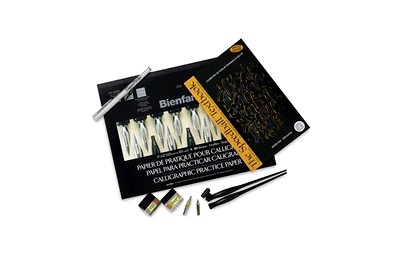
Speedball Complete Calligraphy Kit
A cheaper kit
This kit has many of the same tools as our main pick—just fewer nibs, holders, and ink jars (and no box!). Get this version if you know you want to upgrade to better nibs and holders.
Buying Options
*At the time of publishing, the price was $20.
While our two kit recommendations have the best overall combination of tools for the price, you’ll get better tools and materials that may make learning calligraphy easier by putting together your own starter kit. Our individual picks for nibs, holders, inks, paper, and a calligraphy brush pen are also great upgrades to the Speedball kits once you get into the hobby.
Upgrade pick
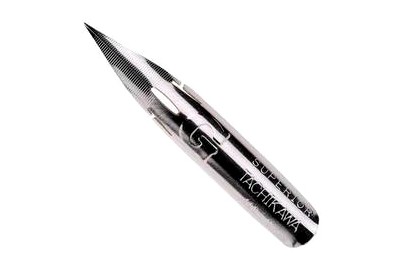
Tachikawa G
The best nib
Offering the most consistent ink flow, this is the easiest nib to write with, and it produces one of the best ranges of thin to thick lines.
Buying Options
If you want a nib that’s slightly easier to use for beginners, we recommend the Tachikawa G. It’s a little more flexible than the nibs in the Speedball kit, which makes it easier to write with. This nib was the favorite of all our testers (beginners and pros), who found that it produced the smoothest flow of ink onto the paper. It fits into most of the holders in the Speedball kit, as well as our upgrade holder.
Upgrade pick
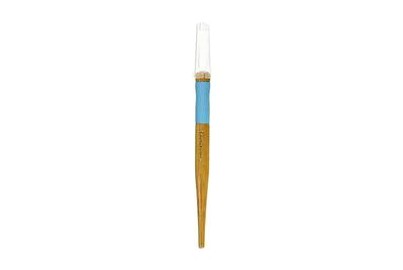
Tachikawa T-40 Comic Pen Nib Holder
The best holder
Our testers liked this holder best due to its comfortable grip. It’s one of the only holders we found with a plastic cap to prevent the nib from scratching your stuff.
Buying Options
*At the time of publishing, the price was $10.
Speaking of which, our testers unanimously preferred the Tachikawa T-40 Comic Pen Nib Holder for its finger grip, which made it more comfortable to hold. This was the only holder we found with a plastic cap that protects the nib and keeps it from scratching your stuff in a bag. Because it’s a universal holder, it’ll work with almost all the nibs in the Speedball kit. If you simply want to purchase one calligraphy “
“
pen,” we recommend this holder with the Tachikawa G nib.
Also great
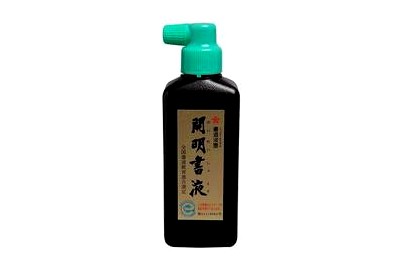
Moon Palace Sumi Ink
Our favorite ink
The creamiest, smoothest ink we tried. It writes in a very dark black and can’t be beat for consistent flow.
Buying Options
While we like the india inks that come in the Speedball kit, we think most beginners will prefer the slightly more viscous consistency of a sumi ink. Moon Palace Sumi Ink was the best one we tried. Our testers found they were able to achieve more consistently smooth lines with this ink, and of the five inks we tested, it dried to the richest black color. The Moon Palace ink also comes highly recommended from our experts.
Also great
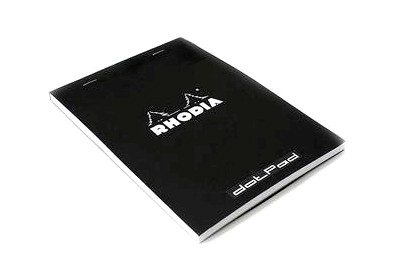
Rhodia dotPad
Best grid paper
The dots on this pad provide guidelines that help to ensure your lettering is consistent, without stealing your attention from the curly letters on the page.
Buying Options
*At the time of publishing, the price was $11.
For practicing even lettering, we recommend the Rhodia dotPad. Among the four papers we tried, its smooth texture was the easiest to write on, even with scratchier nibs. The dot grid is less distracting than the lined grid on other papers, and the perforated pages are easy to rip away as you practice.
Also great
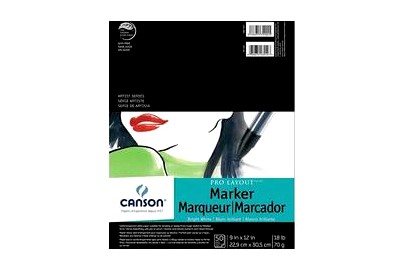
Canson Artist Series Pro Layout Marker Pad
Better for tracing
The paper in this pad is transparent, but sturdier than tracing paper. It’s awesome for practicing with a line sheet behind it or tracing over someone else’s curvy lettering.
Buying Options
*At the time of publishing, the price was $10.
We suggest the Canson Artist Series Pro Layout Marker Pad if you want to trace letters. Translucent but not thin and delicate like vellum or tracing paper, this paper allows you to easily copy script from a guide sheet or even the textbook page from the Speedball Collector’s Kit. One of our experts recommended it, too.
Also great
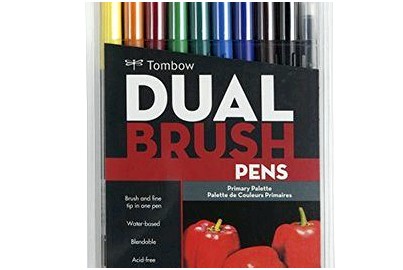
Tombow Dual Brush Pens
A brush-pen alternative
If you want a pen that doesn’t involve dipping a nib into ink, these double-sided pens are the easiest we’ve found to write with. The medium-firm tips created the best lines in our tests.
Buying Options
*At the time of publishing, the price was $12.
If you’re looking for a way to warm up your writing hand, or if you want to address a ton of envelopes (say, for holiday cards or DIY wedding announcements), get Tombow’s Dual Brush Pens. These pens come with two tips, brush and pointed, so you can choose to practice multiple styles at once. Of the 10 pens we tested, these were the easiest to write with. Other pens had tips that were either too soft or too hard, whereas the Tombow pens fell somewhere in the middle—nice to brush with, but not too floppy. We also like that they come in a range of colors.
Everything we recommend

Speedball Calligraphy Collector’s Set
A good starter kit
This is the best affordable kit we tried. We like that its multiple nibs, holders, and ink fit in a sturdy wood box and that it comes with a fun font booklet.
Buying Options
*At the time of publishing, the price was $36.

Speedball Complete Calligraphy Kit
A cheaper kit
This kit has many of the same tools as our main pick—just fewer nibs, holders, and ink jars (and no box!). Get this version if you know you want to upgrade to better nibs and holders.
Buying Options
*At the time of publishing, the price was $20.
Upgrade pick

Tachikawa G
The best nib
Offering the most consistent ink flow, this is the easiest nib to write with, and it produces one of the best ranges of thin to thick lines.
Buying Options
Upgrade pick

Tachikawa T-40 Comic Pen Nib Holder
The best holder
Our testers liked this holder best due to its comfortable grip. It’s one of the only holders we found with a plastic cap to prevent the nib from scratching your stuff.
Buying Options
*At the time of publishing, the price was $10.
Also great

Moon Palace Sumi Ink
Our favorite ink
The creamiest, smoothest ink we tried. It writes in a very dark black and can’t be beat for consistent flow.
Buying Options
Also great

Rhodia dotPad
Best grid paper
The dots on this pad provide guidelines that help to ensure your lettering is consistent, without stealing your attention from the curly letters on the page.
Buying Options
*At the time of publishing, the price was $11.
Also great

Canson Artist Series Pro Layout Marker Pad
Better for tracing
The paper in this pad is transparent, but sturdier than tracing paper. It’s awesome for practicing with a line sheet behind it or tracing over someone else’s curvy lettering.
Buying Options
*At the time of publishing, the price was $10.
Also great

Tombow Dual Brush Pens
A brush-pen alternative
If you want a pen that doesn’t involve dipping a nib into ink, these double-sided pens are the easiest we’ve found to write with. The medium-firm tips created the best lines in our tests.
Buying Options
*At the time of publishing, the price was $12.
Thanks for subscribing!
You’ll be hearing from us soon.
The research
Why you should trust us
To get a sense of the best tools and resources for new and improving calligraphers, we spoke with four experts: Alaïa Giglio, owner of the Clay & Ink calligraphy studio; Lindsey Bugbee, calligraphy teacher and blogger at The Postman’s Knock; Rodger Mayeda, bespoke pen maker and proprietor of Rodger’s Pen Box; and Han Cao, expert tester from the Paperfinger calligraphy house. We also researched numerous calligraphy blogs and tutorials to learn what beginning calligraphers need.
Although I’ve written guides for The Wirecutter in the past (including for sheets, bath mats, and lumbar-support pillows), I was a total beginner to calligraphy when I embarked on my research for this guide. Luckily, this meant I could approach all of the tools we recommend from a beginner’s perspective, and I’ve recommended only those that I know are the easiest to work with.
What you need to get started with calligraphy
Calligraphy comes from the Greek word kalligraphia, meaning “
“
beautiful writing.” To start practicing this ancient art form, you need only pens, ink, and paper (and, perhaps, guidance from a book or teacher). If you’re serious about learning, you’ll want a dip pen, which consists of a holder (the pen-like utensil you grip when writing) attached to a nib (the metal tip that holds the ink and provides the writing point); this setup allows you to experiment with styles of writing by swapping out nibs, holders, and inks.
If you simply want to letter holiday envelopes or wedding invitations and aren’t necessarily ready to pick up a dip pen, you may be happier with a brush marker or a cartridge-filled pen. For this guide, we didn’t focus on these options, since most of our experts recommended dip pens. But we do have one recommendation for a good brush pen, and we plan to test more for a future update. These pens would be great ways to practice your beautiful writing before moving on to a pen dipped in ink.
If you’re looking for resources to learn calligraphy, check out the suggestions in our calligraphy resources section.
How we picked and tested
We tested a range of tools and materials with pro Han Cao (center) from the calligraphy house Paperfinger. Photo: Kyle Fitzgerald
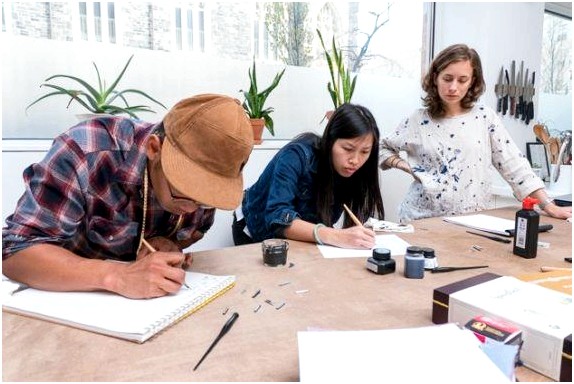
We tested each holder to see how easy it was to grip and to work with, and we tried each nib to see how much ink it allowed to flow onto the paper. Photo: Kyle Fitzgerald
As a beginner myself, I turned to experts to learn everything there was to know about calligraphy pens and how to assemble a great beginner calligrapher’s kit. While we initially considered testing only nibs and holders, we quickly realized that it wouldn’t be useful to recommend the cake without the icing, so we decided to test papers, inks, and prepackaged kits, as well.
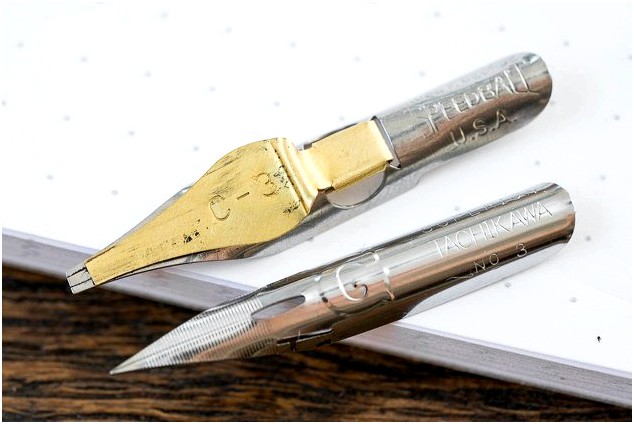
Nibs come in two styles, pointed and chiseled. Much of modern calligraphy (PDF) relies on the pointed nib, while many classical styles—such as gothic or black letter—call for a chiseled-edge nib. Since the chiseled-edge nibs generally work better for older, more advanced calligraphy styles, we decided not to focus on them. But if you’re an intermediate calligrapher looking to experiment with new or different tools, consider the selection at John Neal Bookseller. (Our calligraphy-kit pick also comes with an assortment of chiseled nibs.)
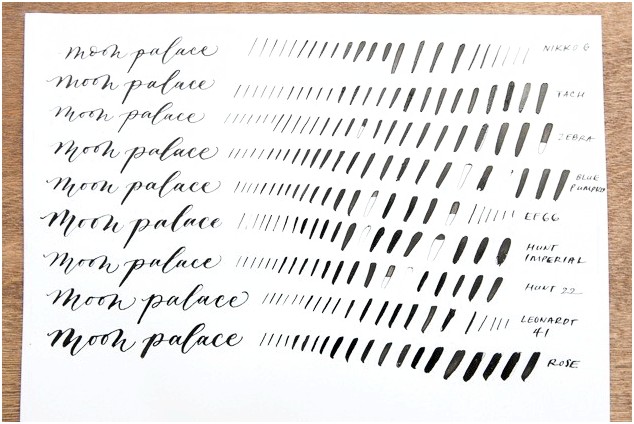
The most important quality of a great nib is how stiff it is, said Alaïa Giglio, proprietor of Clay & Ink. When you’re writing, applying pressure to the nib starts the ink flow. Pointed nibs have two prongs that taper together to form the point of the pen. When you put only light pressure on the nib, the tines barely spread, producing thin lines; when you apply more pressure, the tines spread, creating thicker, heavier lines. If the nib is too stiff, you can have difficulty pressing down sufficiently to get any ink flow. But the tines of a very flexible nib spread with little pressure, which can prompt ink to flow too quickly and cause ink pooling. That’s why a nib of medium flexibility works better for the novice.
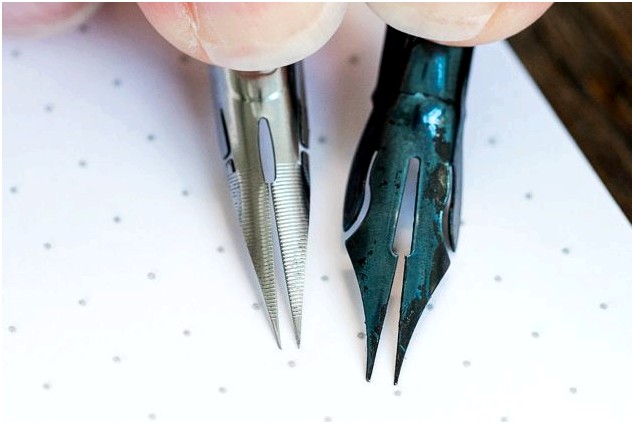
Pen holders also come in two primary styles: straight and oblique. For most beginners, the straight holder is the easier tool to get started on. It’s similar to a normal pen in that the nib attaches at the end of the holder and points straight out. Rodger Mayeda, who makes holders, told us, “
“
A good straight holder should be comfortable to grip, is well made, and should include a universal insert which will hold a variety of different nibs and nib sizes, or should be made to hold a number of different nibs.” An oblique holder—which holds the nib to the side and at a slight angle—helps you more easily achieve a classic slanted script and is more difficult to use, so it’s better for more-advanced beginners. (Lindsey Bugbee of The Postman’s Knock gives a great explanation of how oblique holders work.)
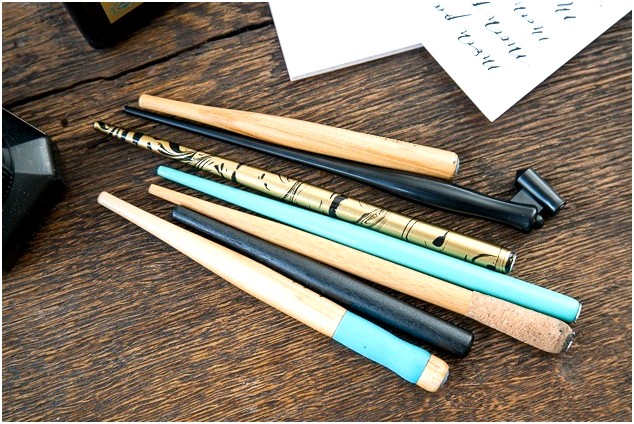
A grip or ergonomic shaping in the handle of the holder can make writing easier, and a cap will keep a nib from scratching or smearing ink when you’re not using the pen. We didn’t find many holders that came with grips or caps, but we ended up preferring those that did.
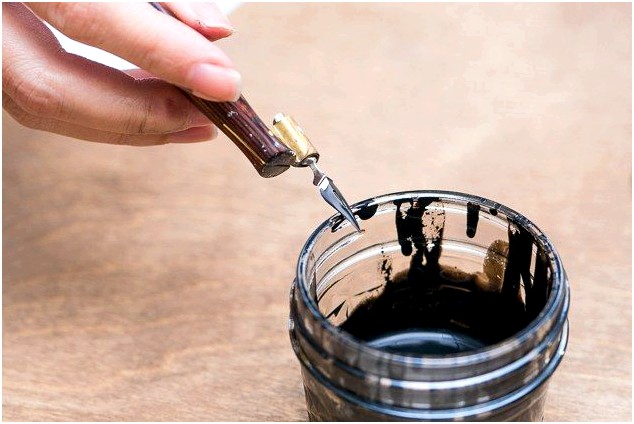
While we focused on finding the best pen and nib, we also tested inks and papers. Although the best ink is a matter of personal preference, certain inks will make writing more pleasant for a beginner. Essentially, you want an ink that’s not too watery—which may cause it to run all over cheap practice paper—but not so viscous that you have to water it down. Beginners should start with ink they can use as is, right out of the jar or bottle. The ink should have an even and consistent flow from the nib, and it shouldn’t spread—an effect called feathering—on the paper (although whether it does also depends on the type of paper you’re using). The best inks for beginners dry to a dark, rich color and ideally should be waterproof, or at least not smudge excessively when dampened.
India ink and sumi ink are two of the most popular types among calligraphers, and they’re what we recommend for beginners. Sumi inks have a thicker, satiny texture and dry to a matte finish. They’re also susceptible to smudging, even after they’re dry, should you get water on them. India inks are a bit runnier (but not watery) and dry to a shinier finish. Some (but not all) india inks are waterproof, so they shouldn’t smudge once dried. We still prefer sumi inks overall because of their smooth texture and consistent lettering.
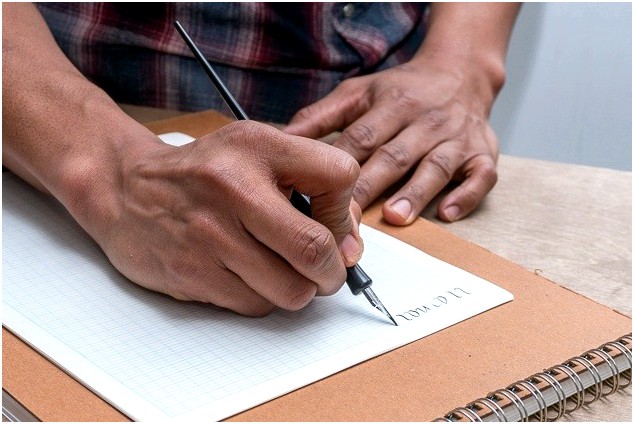
Any paper that allows you to write smoothly and doesn’t cause the ink to feather is more than suitable for getting started practicing calligraphy strokes—you can even use printer paper. We looked for papers that were smooth in texture, heavy enough to keep ink from soaking through, and made to prevent unattractive spreading of the ink. We didn’t test papers specifically designed as “
“
calligraphy paper,” because they can be very expensive and aren’t necessary for beginners. Alaïa Giglio recommended paper that’s durable yet still transparent enough that you can lay a calligraphy worksheet behind it and trace practice letters. We also looked for papers with a lined or dotted grid, which can be helpful for guiding a calligrapher in keeping lettering sizes consistent and lines straight.
Our expert recommended paper that’s durable yet still transparent enough that you can lay a calligraphy worksheet behind it and trace practice letters.
After speaking with experts, we consulted craft stores such as Michaels and Jo-Ann, art-supply stores like Blick, and calligraphy-oriented retailers such as JetPens, John Neal Bookseller, and Paper & Ink Arts to see what calligraphy supplies were available. We also researched on blogs and browsed calligraphy tutorials to determine what tools to test and how to get set up. We chose a range of products to test based on this research and recommendations from experts and popular calligraphy sites. We also tested kits that had high owner ratings. Since most of the popular tools for beginners were under $10 apiece, we weren’t worried about making selections based on price.
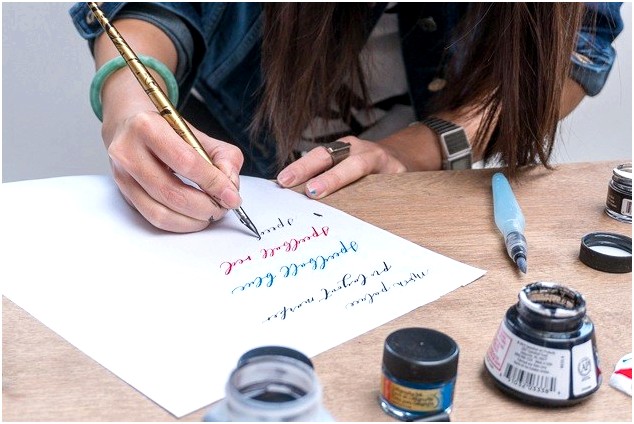
We then held testing sessions with friends and experts alike to figure out which tools we liked best. For the first round of tests, pro calligrapher Han Cao and some friends of The Wirecutter came to our test home to try all of our tools. We tested the nibs for the consistency of their ink flow, how thick or thin a line they could make, and how they reacted to significant pressure. We noted which nibs fit into our universal holders, and which were too small (or too big). Our testers tried all the holders to see which models they thought were the most comfortable to grasp.
We tested each of the inks to see how pleasant they were to write with, how smoothly they flowed out of the nibs, and how frequently we had to re-dip our nibs. We tested every ink with every test nib to determine if the ink flowed smoothly overall or only from certain nibs. Then we tried each of the inks on each paper we were testing to see if they feathered or ran. To test the permanence of our inks, we let them dry and then ran a moist cloth over the lettering to see which smudged the least. Finally, we tested papers to see which were the smoothest and easiest to write on with the most nibs.
I then brought the top nibs, holders, inks, and papers home and had a calligraphy-testing party with a few friends to narrow down the options. Our skill levels ranged from total beginner to advanced beginner. With so many novices in the room, we were easily able to identify the best stuff for people who are just starting out.
Best starter calligraphy kit: Speedball Calligraphy Collector’s Set
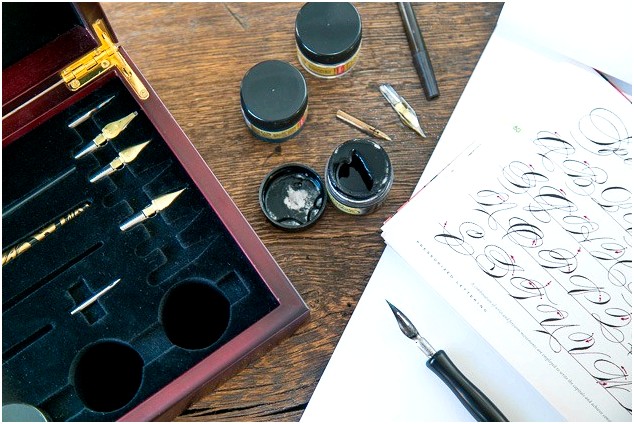

Speedball Calligraphy Collector’s Set
A good starter kit
This is the best affordable kit we tried. We like that its multiple nibs, holders, and ink fit in a sturdy wood box and that it comes with a fun font booklet.
Buying Options
*At the time of publishing, the price was $36.
If you’re just getting into calligraphy, an all-in-one kit is a great way to start, and we recommend the Speedball Calligraphy Collector’s Set. Of the three kits we tried, this one has the best combination of basic tools at an affordable price. You can get better nibs, holders, and ink if you buy them separately (see our recommendations below), but the tools here are good enough for most beginners and will give you plenty of options. We also like that the set comes in a beautiful box, making this not only a great kit to buy for yourself, but also a nice gift for a friend or loved one.
While other kits we tested offer tools from a mix of brands, everything in this kit is from Speedball. The kit includes two straight holders, one oblique holder, a small nib holder, four pointed nibs, four chiseled nibs, three colors (black, red, and blue) of india ink, nib cleaner, and a starter textbook. We actually prefer the quality of the tools in the more-expensive Paper & Ink Arts kit we tried, but we thought it was too expensive for most beginners, and we were concerned that it wasn’t as widely available. The Speedball kit really gives you everything you need at the right price for a beginner, and it’s available from more retailers.
We particularly like the straight and oblique holders in this kit (we recommend one of them as our runner-up pick for a separate holder). We also like Speedball’s india inks. In our tests, they didn’t write quite as smoothly as our recommended sumi ink picks, but they were consistently the most colorfast when we brushed them with water. They’re also the ink that Lindsey Bugbee of The Postman’s Knock recommends for beginners.
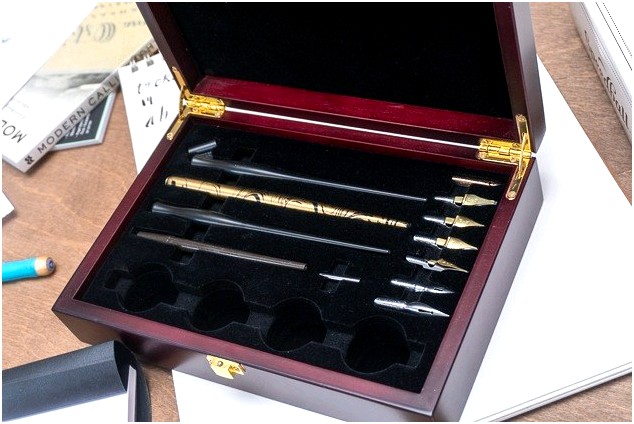
One downside to this kit is that none of the included nibs really blew us away. Each one was a little stiff and more difficult to work with than some of our favorite nibs. The stiffness made it tougher for us to apply enough pressure to produce thicker lines, and the ink flow was pretty inconsistent compared with what we saw from those other nibs. For better results, upgrade to the Tachikawa G nib or the Nikko G nib (either one works fine with Speedball holders).

Speedball Complete Calligraphy Kit
A cheaper kit
This kit has many of the same tools as our main pick—just fewer nibs, holders, and ink jars (and no box!). Get this version if you know you want to upgrade to better nibs and holders.
Buying Options
*At the time of publishing, the price was $20.
If the Collector’s Set sells out, or if you’d prefer a slightly cheaper and simpler kit, we also like the Speedball Complete Calligraphy Kit. It comes with fewer nibs and holders (see the breakdown) and only one black ink, and it doesn’t include the fancy wood storage box. We think the lack of nibs is the biggest drawback, as the only pointed nib that comes in the Complete Calligraphy Kit is one that we found to be very scratchy during testing. This isn’t necessarily a dealbreaker; if you already know you want to upgrade to some of our nib and holder picks, this kit may be better for you than our main pick, especially since it comes with the Speedball calligraphy textbook, as well as a notebook and a brush marker. But if you want a full, ready-to-go set with no additional legwork, our main pick still has more to offer.
Tools and materials in the kits:
Best calligraphy nib: Tachikawa G
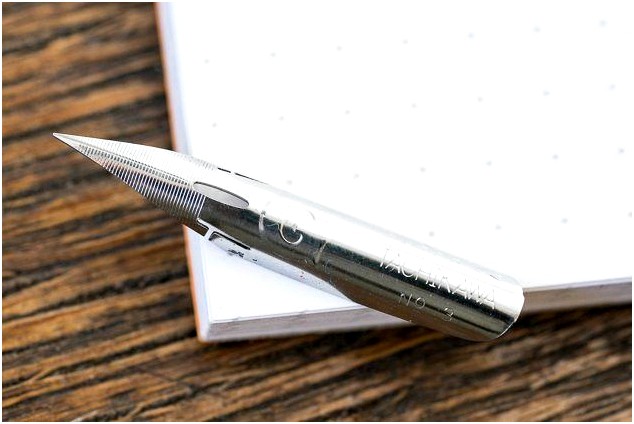
Upgrade pick

Tachikawa G
The best nib
Offering the most consistent ink flow, this is the easiest nib to write with, and it produces one of the best ranges of thin to thick lines.
Buying Options
Our favorite calligraphy nib, among our novices and experts alike, was the Tachikawa G. Of the nine nibs we tested, it had the best balance of stiffness and flexibility, producing the smoothest flow of ink on the paper.
The Tachikawa G was stiff enough that it didn’t allow ink to flow too quickly, so we achieved the hairlines necessary for the dainty effects so characteristic of modern calligraphy. But it was still flexible enough that our testers could write thick lines, too. Some of the other nibs were equally good at creating thin and thick lines, but the Tachikawa was easier to use. Compared with the very stiff nibs included in the Speedball kit, the Tachikawa was easier to write with and created a more even ink flow.
Also great
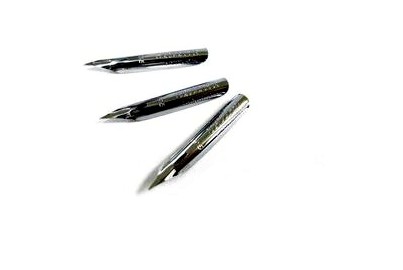
A slightly stiffer nib
This slightly stiffer nib keeps beginners from pressing too hard and makes controlling ink flow easier. But our testers didn’t find it as satisfying to write with.
Buying Options
*At the time of publishing, the price was $10.
The Nikko G is a great alternative if the Tachikawa G sells out or if you just want to try both. This nib is slightly stiffer than the Tachikawa G and requires more pressure to get similar ink flow, which in our tests made it a little more difficult for us to write with. But it’s still a great nib, and it’s more flexible than the nibs in the Speedball kit. It’s also a favorite among calligraphy bloggers. Lindsey Bugbee of The Postman’s Knock loves the Nikko G: “
“
Beginners need a stronger nib as they figure out how to exert and let up on pressure,” she told us in an interview. “
“
The Nikko G nib is practically indestructible, and therefore a great nib to begin with.”
Both the Nikko G and the Tachikawa G are Japanese nibs made primarily for creating manga, ink-drawn comics. Pen maker Rodger Mayeda told us these nibs are “
“
great for beginners, as they are very smooth, have a medium flexibility, are long lasting, inexpensive, and fairly easy to get.”
Best holder: Tachikawa T-40 Comic Pen Nib Holder
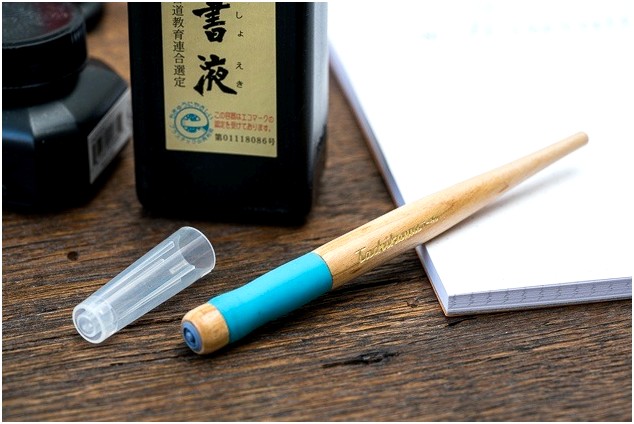
Upgrade pick

Tachikawa T-40 Comic Pen Nib Holder
The best holder
Our testers liked this holder best due to its comfortable grip. It’s one of the only holders we found with a plastic cap to prevent the nib from scratching your stuff.
Buying Options
*At the time of publishing, the price was $10.
If you’re anything like me, and you tend to hold your pens in a death grip, the Tachikawa holder’s ergonomic pad will help keep your fingers more comfortable. As for the pen cap, one of our testers especially loved it, noting that the cap “
“
is great for when you’re traveling, want to leave the nib in the pen, and don’t want to worry about it scratching up everything else in your pencil case.” None of the other holders we tested had a cap or an ergo grip, and once we switched back to other holders, we found ourselves missing those features terribly.
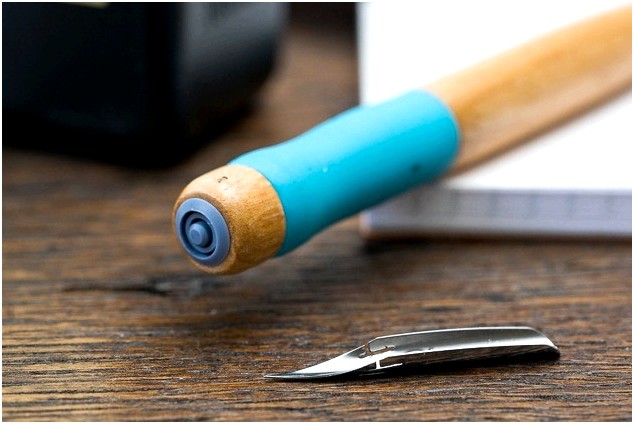
The Tachikawa holder, like all of the holders we tested, is a “
“
universal” holder. In theory, this means they should be able to fit any nib. But some of the tested holders struggled with the smallest nib we tried (the Brause EF 66). The Tachikawa T-40 design handles the size issue best, offering a larger and a smaller ring for inserting nibs rather than metal prongs to hold them. Compared with the other universal holders we tested, we found it easier to fit a smaller nib into the Tachikawa holder.
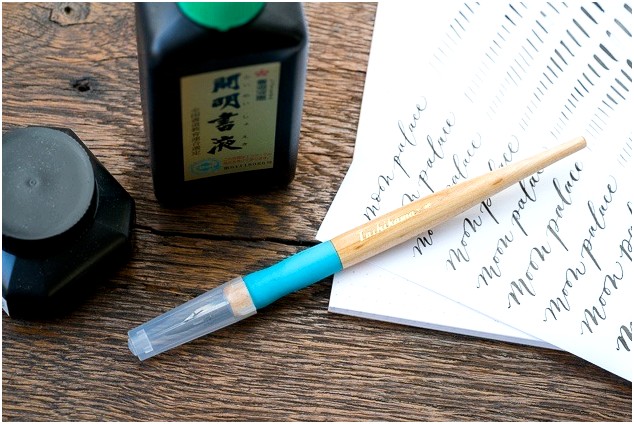
Also great
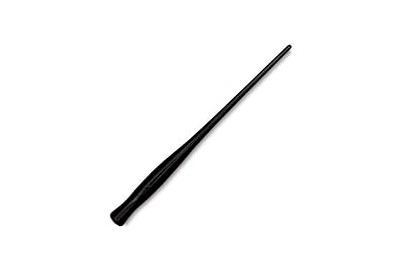
Speedball Pen Nib Holder
A lighter holder
Some of our testers found this holder to be too light, but it’s comfortable to hold and cheaper than the Tachikawa T-40. It’s also more widely available.
Buying Options
*At the time of publishing, the price was $5.
If you don’t care about an ergo grip or a cap, we also love the Speedball Pen Nib Holder, which is one of the holders included in our recommended Speedball kit. Some of our testers complained that this holder was a bit on the light side, and our expert tester said she would recommend buying something with more weight once you get more serious about calligraphy. This holder also didn’t fit the smallest nib we tested, so it’s not quite as versatile as the Tachikawa holder. Regardless, the Speedball holder was pleasant to grasp, despite its lack of an ergonomic grip, and its length provided a nice counterbalance to its light weight. Priced from $1 to $6, the Speedball holder is an inexpensive choice, as well. It’s also commonly recommended on calligraphy blogs.
Best ink: Moon Palace Sumi Ink
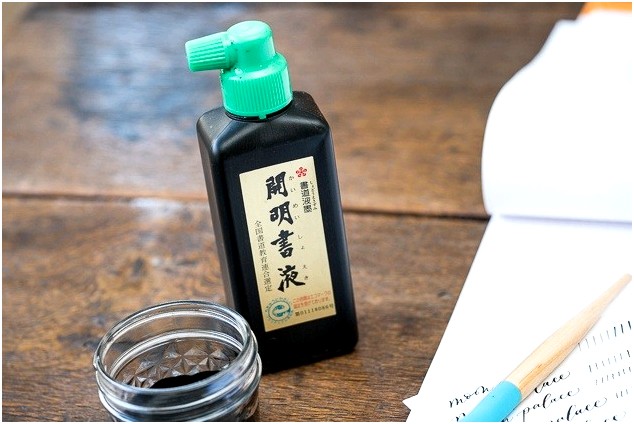
Also great

Moon Palace Sumi Ink
Our favorite ink
The creamiest, smoothest ink we tried. It writes in a very dark black and can’t be beat for consistent flow.
Buying Options
You can find a lot of good inks that would be well-suited to calligraphers of any level, but of the five we tried, Moon Palace Sumi Ink wrote in the darkest, richest black. Our testers universally liked this ink, which also came highly recommended by our experts.
We preferred the Moon Palace ink over the india ink that came in the Speedball kit because the Moon Palace ink was a bit thicker, and we had an easier time getting smooth, consistent lines out of it. A good ink should enhance the writing experience you have with a nib, and this one had that effect with all of our favorite nibs (and even some of our least favorite nibs). It dried with a matte finish, and when we tried to smudge it with water, it ran significantly less than the other sumi inks. (The only ink that didn’t smudge was the india ink from the Speedball kit.) The Moon Palace ink is also great because it simply goes blank when the pen runs out of ink, rather than fading to a lighter black or getting grainy like a water-based ink (such as the Higgins Eternal black ink we tested).
Also great
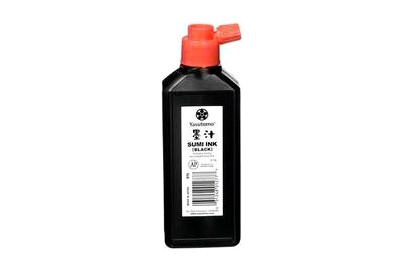
Yasutomo KY6 Sumi Ink
A less-colorfast sumi ink
This ink wrote almost as smoothly as the Moon Palace ink but smudged more in our tests.
Buying Options
*At the time of publishing, the price was $7.
If the Moon Palace ink sells out, we recommend Yasutomo KY6 Sumi Ink. It wrote nearly as smoothly as the Moon Palace ink did in our tests, and it’s slightly cheaper. The drawbacks to this ink are that it ran slightly more than the Moon Palace ink in our water tests, and expert Han Cao told us that from her experience this ink could be relatively corrosive to nibs (more so than the Moon Palace ink). Sumi ink in general can be corrosive, and remaining diligent about cleaning your nibs will not only keep them writing smoothly but will also extend their lifespan. When using any sumi ink, you should make sure to clean the nibs thoroughly during and after use.
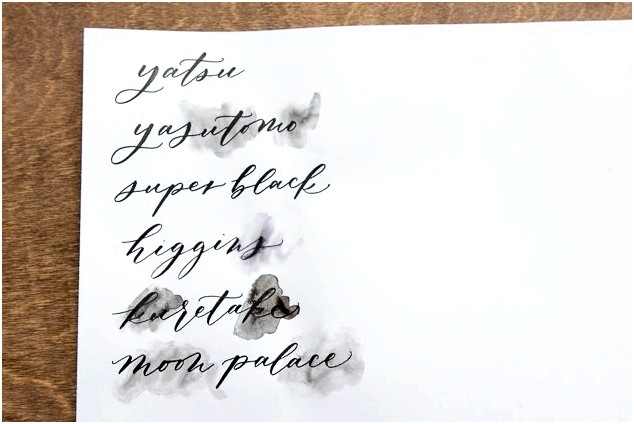
Best practice paper: Rhodia dotPad
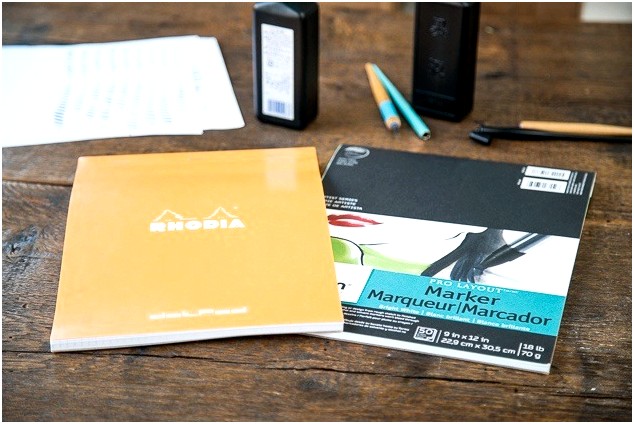
Also great

Rhodia dotPad
Best grid paper
The dots on this pad provide guidelines that help to ensure your lettering is consistent, without stealing your attention from the curly letters on the page.
Buying Options
*At the time of publishing, the price was $11.
Of the four papers we tried, we think the Rhodia dotPad is best for beginners practicing their letters. In our tests it had the smoothest paper and was the easiest to write on, even with the scratchier nibs we tested. Our expert tester, Han Cao, told us she thought that the Rhodia paper could “
“
withstand [the most] mashing of the pen”—in other words, take the most downward pressure from a pen’s pointed nib.
Another major benefit of this dot-grid paper is, of course, the grid. We found that it was easier to write consistently uniform letters when we had some guidelines to follow. Each sheet is perforated at the top, too, so tearing pages out as you go is easy enough, if you prefer.
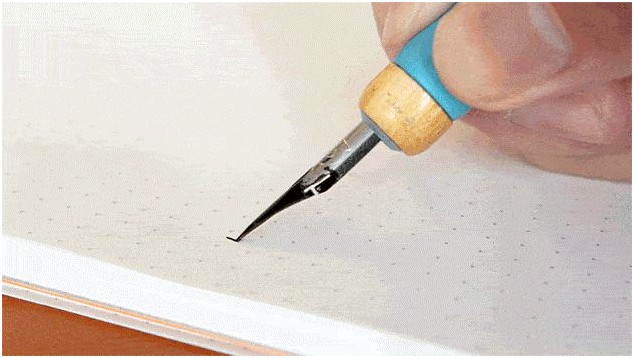
Also great

Canson Artist Series Pro Layout Marker Pad
Better for tracing
The paper in this pad is transparent, but sturdier than tracing paper. It’s awesome for practicing with a line sheet behind it or tracing over someone else’s curvy lettering.
Buying Options
*At the time of publishing, the price was $10.
If you want a paper for tracing calligraphy letters, we like the Canson Artist Series Pro Layout Marker Pad. Alaïa Giglio recommended this slightly transparent paper, which is just a little thicker and sturdier than tracing paper or vellum. We easily put practice sheets behind the paper and traced on it, without the paper ripping or bunching as typical tracing paper might. If you want to print out an alphabet or a guide sheet, or even put this paper over the textbook from the Speedball Calligraphy Collector’s Set, tracing any of those things will be seamless. And the best part is that you get professional-looking letters at the end!
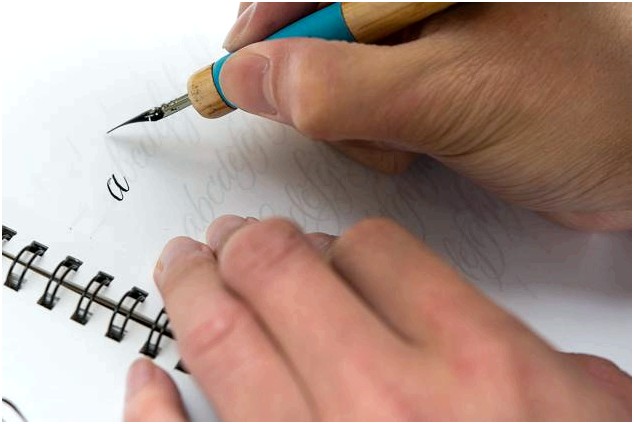
A good brush pen: Tombow Dual Brush Pens
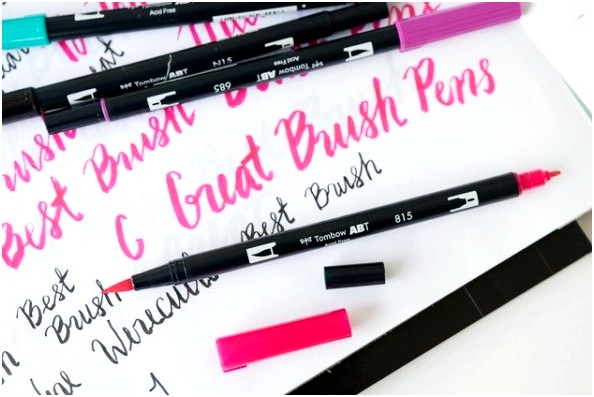
Also great

Tombow Dual Brush Pens
A brush-pen alternative
If you want a pen that doesn’t involve dipping a nib into ink, these double-sided pens are the easiest we’ve found to write with. The medium-firm tips created the best lines in our tests.
Buying Options
*At the time of publishing, the price was $12.
If you’re looking to address a bunch of envelopes but are running short on time, or if you just want a nice way to warm up before moving on to the traditional pen and ink, get Tombow’s Dual Brush Pens. They have dual ends, so you can practice with a brush or a pointed tip. Of the 10 brush markers we tried, our testers found the Tombow Dual Brush Pens the easiest to write with, because of their medium-firm tips. Other pens we tried were either too firm or too soft, making it more difficult to produce attractive lines. In comparison with other dual-tipped markers we tried, both ends of the Tombow Dual Brush Pens felt more natural and easy to hold and write with. These pens also come in a wider variety of colors. We recommend you buy them in a pack, because you’ll get nearly twice as many markers for the same cost, but if you want to choose your own colors, Tombow also sells them individually.
Calligraphy resources
While researching for this guide, we came upon a number of great resources for learning calligraphy basics. If you’re not ready to pay for a class, we pulled together some of our favorite tutorials into this Pinterest board.
The competition
While our testers loved one of the nibs in the JetPens Modern Calligraphy Starter Kit, the other two were scratchy and difficult to get consistent ink flow from. This kit doesn’t offer anything special—certainly nothing that our main pick (which is priced about the same) doesn’t offer.
We love the Paper & Ink Arts Modern Calligraphy Starter Kit, especially because it comes with a selection of 10 different nibs to play with, but for around $55 it seems expensive for a starter kit. It also comes from a small retailer, so we aren’t sure how consistently the kit will stay in stock.
The Brause Blue Pumpkin (Brause 361) was our third-favorite nib, as our advanced-beginner testers found it easy to use to make varied lines.
Testers complained that the Brause EF 66 was too small to fit into regular-size universal holders (it does fit into our holder pick, though), and it felt as if it could easily break if we pressed too hard.
The Hunt Imperial (Hunt 101) was way too scratchy on all of the papers we tested.
The Hunt 22 was equally scratchy on our test papers.
We didn’t like the Leonardt 41 (Hiro 41) because it didn’t hold much ink.
The Brause Rose (Brause 76) had a similar issue with poor ink flow overall.
The Zebra G was stiff, and as a G-style manga nib, it failed to outshine the Tachikawa and Nikko nibs.
Although we didn’t formally test oblique holders, we did try the Speedball Oblique Pen Nib Holder, which came in our tested kits. This style of holder differs from straight holders in that it places the nib off to the left of the pen shaft and tilts the nib to a 45-degree angle relative to the shaft. The holder looks strange and counterintuitive, but I felt that it helped me slow down my lettering and keep that classic calligraphy slant a bit more consistent. Since the nib was already angled in the holder, I found it easier to write slanted letters, with less arm or paper contortion.
The General Pencil Cork Grip Pen Nib Holder got dirty from ink way too easily.
The all-wood Tachikawa T-25 Comic Pen Nib Holder was fine but didn’t stand out.
The Manuscript Glossy was also a good holder, but not better than our main picks.
Speedball Super Black India Ink was the only india ink we tried, and it’s the ink included in our calligraphy-kit pick. In our tests this ink was less fun to write with than our sumi picks, but it was the most colorfast when we applied water to it.
The water-based Higgins Eternal Permanent Black Ink had a thinner consistency than the sumi and india inks we tried, rendering it runny and inconsistent to write with.
The Zig Cartoonist Black Ink we tried bled tremendously and felt poor to write with.
We liked HP Premium Choice Laserjet Paper, a good choice if you want individual sheets. This printer paper is smooth and easy to write on, but it doesn’t offer the added convenience of guidelines or ease of tracing, as our main picks do.
Strathmore 300 Series Drawing Paper isn’t great for calligraphy. All of our testers agreed this paper was far too scratchy.
Brush pens
Although the Faber-Castell Pitt Artists Pen is a nice, easy-to-hold size, our testers felt that the tip was too soft and difficult to write with next to others we tried.
If you want a pair of pens that have finer points with a shorter brush, the Tombow Fudenosuke pen set is excellent for that. One pen has a soft tip and the other has a hard tip. These pens do require you to exert quite a bit of pressure to get good stroke variation, but they produce relatively nice letters overall. We recommend these for a more advanced letterer.
The Tombow Advanced Lettering Set is a good alternative if you want the option of trying out a few different markers, including the Fudenosuke pens (above) and the Tombow Mono Twin marker, in addition to the dual-ends. Our testers, however, didn’t like any of the other markers substantially more than the Tombow dual-ends on their own.
The ink of the Pentel Arts Pocket Brush Pen bled a lot when we tried it, and our testers found it hard for writing letters. It may be good for more stroke-based writing styles, though, like Chinese, Japanese, or Korean character lettering.
The Sakura Pigma Professional Brush pens, which come in a set of three, have floppy tips that our testers found unintuitive to write with.
We thought the Copic Gasenfude was nice for a pen with a soft tip, and it was good for creating large sweeping letters, but the ink was a bit runny, and it didn’t offer a better writing experience than our main pick.
Lindsey Bugbee, The Beginner’s Guide to Modern Calligraphy, The Postman’s Knock, October 7, 2016
Comments are disabled
We respect your privacy. Comments are disabled because they require cookies and you’ve opted out of cookies for this site. You can change your cookie preferences to enable comments.
Never buy junk again.
Sign up for our newsletter to get new reviews each week.
Thanks for subscribing. You’ll be hearing from us soon.
Opt out or contact us at any time.
Wirecutter is a list of wonderful things by Brian Lam and friends, founded in 2011 and a part of The New York Times Company since 2016. Have a question? Just ask.
Let’s be friends!
© 2018 Wirecutter, Inc.

The best deals, delivered daily
Subscribe to our daily deals newsletter to get the best deals delivered straight to your inbox.
Source: thewirecutter.com
